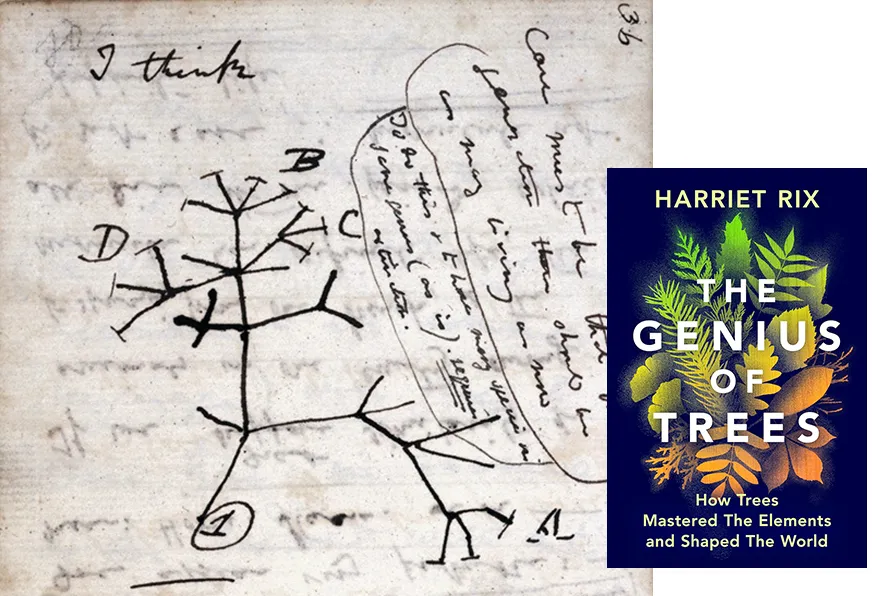GEOFF BOTTOMS appreciates the local touch brought to a production of Dickens’s perennial classic
JOHN GREEN enjoys a highly informative stroll through the evolutionary history of trees and planetary life

 LIFE ON EARTH: Sketch from Charles Darwin's Notebooks on Transmutation of Species (1837), arguably the first example of a phylogenetic tree showing evolutionary relationships. (1) represents a common ancestor. [Pic: Public Domain]
LIFE ON EARTH: Sketch from Charles Darwin's Notebooks on Transmutation of Species (1837), arguably the first example of a phylogenetic tree showing evolutionary relationships. (1) represents a common ancestor. [Pic: Public Domain]
The Genius of Trees – How Trees Mastered the Elements and Shaped the World
Harriet Rix, The Bodley Head, £25
WE are all familiar with trees: almost every urban road is lined with them, our parks offer shade under their canopies, and they form extensive woodlands in the countryside. But how many of us really know anything about their evolution, their significance for our life on Earth, or their complex interrelationships with each other and other plants?
Rix’s fascinating book takes us on an illuminating and highly informative journey through the evolutionary history of trees and planetary life.
Over millions of years, trees have become vital for human welfare. They use water, the sun’s energy and carbon dioxide to manufacture carbohydrates and sugars. Humans and trees have probably lived in collaboration with each other longer than we have with any other group of living beings.
The shape of our hands and our residual fingerprints are evidence of our previous arboreal existence, when trees provided vital safety from predators as well as sustenance in the form of fruits, nuts and seeds. Trees not only provide nourishment but also natural medicines, vital in the fight against disease, as well as supplements, anti-oxidants, vitamins and spices. They also collaborate with bacteria and fungi to help them assimilate the minerals and elements they need, and they play a key role in guiding water courses, both underground and on the surface, rather like non-animal beavers.
Around 6 million years ago, when the first hominids descended from arboreal safety to walk bipedally on the plains, progressing to develop agriculture, they began to rely increasingly on cereals and root crops for food, rather than tree fruits. Trees were then used less as a source of food, but as firewood and building material, and our close symbiotic relationship was severed, with often devastating environmental consequences.
Rix explains how trees first established themselves on the shorelines of seas and lakes, where they had access to sufficient water to survive the relentless heat of the sun. Here they created their own micro-climates, but more importantly, as a result of their transpiration, created so-called “sky rivers” of water, which flow far inland and were responsible for irrigating the arid interiors of the land masses. Without this massive transference of water, the planet would not have developed as it did or made human habitation and agriculture possible. Once this transference was interrupted as a result of deforestation, large areas suffer extreme drought and aridity.
Trees need to “sweat” water in order to cool down and prevent the sun’s heat scorching their fragile foliage. They release up to 97 per cent of the water they take up, and a single tree can give off a thousand litres of water in a day. As this water rises it condenses, lowering the air pressure. If this happens next to the sea, moisture-laden air is sucked in over the forest, setting up a cycle that can continue for miles inland. Twenty billion tons of water vapour arise from the Amazon each day. Even small areas of deforestation there reduce that water cycle significantly.
Trees also develop large root systems to help them take up water, but also to provide them with stability and prevent them from being blown over or washed away in storms. These roots are responsible for breaking down rocks and converting it into soil in which other plants can grow and which then be worked agriculturally.
In the last 1.7 billion years of planetary evolution, our cells diverged and humans and trees have exchanged little if any DNA, although amazingly we humans still share around 30 per cent of our genetic code with trees!
Where would we be without trees? The simple answer is: we wouldn’t be here at all! This book explains this incredible inter-relationship in fluent and engaging prose and is related by someone who fully understands the scientific back story.










